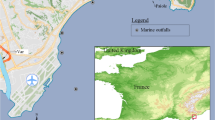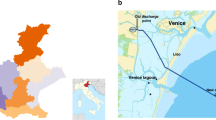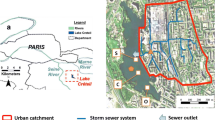Abstract
A 3D hydrodynamic model has been applied to the Curonian Lagoon to study the pollution impact of E. coli on a new beach that might be opened in the lagoon. Through a field survey the E. coli inputs were measured and then used in the numerical model, and through laboratory experiments the decay rate of E. coli was established. The model has been calibrated and validated for the year 2015, and several scenarios have been studied, such as sewage system breakdown, severe weather conditions or high river loads. The model has then been run for a period of 12 years to obtain a robust statistics for the pollution on the planned beach. Results show that the decay rate of E. coli is between 0.55 days and 2.3 days and the modeled decay times are compatible with these numbers. The only scenario that would create a risk for the bathing waters of the beach is a breakdown of the sewage system on the Curonian Spit. In this case the hours (and days) over legally allowable bathing threshold were computed in order to estimate the number of days the beach could be closed. These results have been confirmed by the 12 year simulations. With an influence map analysis the two most critical sewage systems could be identified.








Similar content being viewed by others
References
Armaitiene A, Bertuzyte R, Vaskaitis E (2014) Conceptual framework for rethinking of nature heritage management and health tourism in National Parks. Procedia - Soc Behav Sci, 2nd International Conference on Strategic Innovative Marketing 148:330–337. https://doi.org/10.1016/j.sbspro.2014.07.050
Bathing Water Directive (2006) European council directive 2006/7/EC of 15 February 2006 concerning the management of bathing water quality and repealing directive 76/160/EEC. Off J Eur Commun L64:37–51 http://eur-lex.europa.eu/LexUriServ/LexUriServ.do?uri=OJ:L:2006:064:0037:0051:EN:PDF
Bellafiore D, Guarnieri A, Grilli F, Penna P, Bortoluzzi G, Giglio F, Pinardi N (2011) Study of the hydrodynamical processes in the Boka Kotorska Bay with a finite element model. Dynam Atmos Oceans 52(1–2):298–321
Botero C, Anfuso G, Williams AT, Zielinski S, da Silva CP, Cervantes O, Silva L, Cabrera JA (2013) Reasons for beach choice: European and Caribbean perspectives. J Coast Res 1:880–885. https://doi.org/10.2112/SI65-149.1
Bougeard M, Le Saux J-C, Pérenne N, Baffaut C, Robin M, Pommepuy M (2011) Modeling of Escherichia Coli fluxes on a catchment and the impact on coastal water and shellfish quality. J Am Water Resour As 47(2):350–366. https://doi.org/10.1111/j.1752-1688.2010.00520.x
Burchard H, Petersen O (1999) Models of turbulence in the marine environment – a comparative study of two equation turbulence models. J Marine Syst 21:29–53
Chapra SC (2008) Surface water-quality modeling, 2nd edn. Waveland Press, Illinois
Countrywide census of the population of 2010 for Kaliningrad region (2013) Table 10. The population count of urban districts, municipal districts, urban and rural settlements, urban localities, rural localities. Archived from the primary source 2013–11-28 [In Russian]. www.webcitation.org/6LTFYTQqP
Dailidienė I, Davulienė L (2008) Salinity trend and variation in the Baltic Sea near the Lithuanian coast and in the Curonian lagoon in 1984-2005. J Marine Syst 74:20–29
De Pascalis F, Perez-Ruzafa A, Gilabert J, Marcos C, Umgiesser G (2011) Climate change response of the Mar Menor coastal lagoon (Spain) using a hydrodynamic finite element model. Estuarine Coastal Shelf Sci 114:118–129. https://doi.org/10.1016/j.ecss.2011.12.002
Engström E, Balfors B, Thunvik R (2010) Modeling Bacterial Transport and Removal in a Constructed Wetland System. Excerpt from the Proceedings of the COMSOL Conference 2010 Paris
European Environment Agency (EEA 2013) (2013) Balancing the future of Europe's coasts— knowledge base for integrated management. EEA Report, pp. 64. doi:https://doi.org/10.2800/99116
Ferrarin C, Umgiesser G (2005) Hydrodynamic modeling of a coastal lagoon: the Cabras lagoon in Sardinia, Italy. Ecol Model 188:340–357
Ferrarin C, Razinkovas A, Gulbinskas S, Umgiesser G, Bliudziute L (2008) Hydraulic regime-based zonation scheme of the Curonian Lagoon. Hydrobiologia 611:133–146
Ferrarin C, Umgiesser G, Bajo M, Bellafiore D, De Pascalis F, Ghezzo M, Mattassi G, Scroccaro I (2010) Hydraulic zonation of the lagoons of Marano and Grado, Italy. A modelling approach. Estuar Coast Shelf S 87(4):561–572
Ferrarin C, Ghezzo M, Umgiesser G, Tagliapietra D, Camatti E, Zaggia L, Sarretta A (2013) Assessing hydrological effects of human interventions on coastal systems; numerical application to the Venice lagoon. Hydrol Earth Syst Sci 17:1733–1748
Falconer RA, Lin B (1997) Three-dimensional modelling of water quality in the Humber estuary. Water Res 31(5):1092–1102. https://doi.org/10.1016/S0043-1354(96)00333-8
Fiandrino A, Martin Y, Got P, Bonnefont JL, Trousselliera M (2003) Bacterial contamination of Mediterranean coastal seawater as affected by riverine inputs: simulation approach applied to a shellfish breeding area (Thau lagoon, France). Water Res 37:1711–1722. https://doi.org/10.1016/S0043-1354(02)00573-0
Funkquist L (2003) A unified model system for the Baltic Sea. Elsevier Oceanogr Ser 69:516–518. https://doi.org/10.1016/S0422-9894(03)80082-X
Gao G, Falconer RA, Lin B (2015) Modelling the fate and transport of faecal bacteria in estuarine and coastal waters. Mar Pollut Bull 100(1):162–168. https://doi.org/10.1016/j.marpolbul.2015.09.011
Gourmelon M, Lazure P, Hervio-Heath D, Le Saux JC, Caprais MP, Le Guyader FS, Catherine M, Pommepuy M (2010) Microbial modelling in coastal environments and early warning systems: useful tools to limit shellfish microbial contamination. In: Rees G, Pond K, Kay D, Bartram J, Santo Domingo J (eds) Safe Management of Shellfish and Harvest Waters. IWA Publishing, London, pp 298–311
Haller I, Stybel N, Schumacher S, Mossbauer M (2011) Will beaches be enough? Future changes for coastal tourism at the German Baltic Sea. J Coast Res 61:70–80. https://doi.org/10.2112/SI61-001.68
Head PC, Crawshaw DH, Dempsey P, Hutchings CJ (1992) Bathing in the rain – the use of mathematical models for storm water management to achieve bathing water quality (the Fylde coast-NW England). Water Sci Technol 25:59–68
2Jakimavičius D (2012) Changes of water balance elements of the Curonian Lagoon and their forecast due to anthropogenic and natural factors. Dissertation, Kaunas University of technology [In Lithuanian]
Kashefipour SM, Lin B, Harris E, Falconer RA (2002) Hydro-environmental modelling for bathing water compliance of an estuarine basin. Water Res 36:1854–1868. https://doi.org/10.1016/S0043-1354(01)00396-7
Liu L, Phanikumar MS, Molloy SL, Whitman RL, Shively DA, Nevers MB, Schwab DJ, Rose JB (2006) Modeling the Transport and Inactivation of E. coli and Enterococci in the Near-Shore Region of Lake Michigan. Environ Sci Technol 40(16). doi: https://doi.org/10.1021/es060438k
Martin Y, Bonnefont JL, Guiennet B (1990) Etude experimentale de la decroissance des bacteries temoins de contamination fecale en milieumarin. Recherche de modeles de simulation operationnels. Bull Liaison Lab P Ch 169:109–116
Olenina I, Olenin S (2002) Environmental problems of the south-eastern Baltic coast and the Curonian lagoon. In: Schernewski PD, Habil G, Schiewer PDU (eds) Baltic coastal ecosystems, central and eastern European development studies. Springer, Berlin Heidelberg, pp 149–156
Pommepuy M, Hervio-Heath D, Caprais MP, Gourmelon M, Le Guyader F (2005) Fecal contamination in coastal areas: an engineering approach. In: Belkin S, Colwell RR (eds) Oceans and health: pathogens in the marine environment. Springer, New York, pp 331–359
Schernewski G (2015) Baltcoast A systems approach framework for coastal research and management in the Baltic. Bonus in brief May 2015:4. http://www.bonusportal.org/files/4054/BiB_May_2015.pdf
Schernewski G, Støttrup JG, Boslough R (2016) Approaches to ensure an effective coastal zone management in the Baltic and beyond. Coast and Mar 25:4–5. http://eucc-d-inline.databases.eucc-d.de/files/documents/00001176_coastalandmarine_2016-2.pdf
Scott A, Wang BY, Kim H, Torkzaban S, Šimůnek J (2014) Modeling microorganism transport and survival in the subsurface. J Environ Qual 43:421–440. https://doi.org/10.2134/jeq2013.05.0212
Servais P, Garcia-Armisen T, George I, Billen G (2007) Fecal bacteria in the rivers of the seine drainage network (France): sources, fate and modelling. Sci Total Env 375:152–167. https://doi.org/10.1016/j.scitotenv.2006.12.010
Smagorinsky J (1963) General circulation experiments with the primitive equations, I. The basic experiment. Mon Weather Rev 91:99–152
Statistics Lithuania (2015) http://osp.stat.gov.lt
Umgiesser G, Melaku Canu D, Cucco A, Solidoro C (2004) A finite element model for the Venice lagoon. Development, set up, calibration and validation. J Marine Syst 51:123–145
Umgiesser G, Ferrarin C, Cucco A, De Pascalis F, Bellafiore D, Ghezzo M, Bajo M (2014) Comparative hydrodynamics of 10 Mediterranean lagoons by means of numerical modeling. J Geophys Res-Oceans 119(4):2212–2226. https://doi.org/10.1002/2013JC009512
Umgiesser G, Zemlys P, Ertürk A, Razinkovas-Baziukas A, Mėžinė J, Ferrarin C (2016) Seasonal renewal time variability in the Curonian lagoon caused by atmospheric and hydrological forcing. Ocean Sci 12:391–402. https://doi.org/10.5194/os-12-391-2016
Yáñez MA, Valor C, Catalán V (2006) A simple and cost-effective method for the quantification of total coliforms and Escherichia Coli in potable water. J Microbiol Methods 65:608–611. https://doi.org/10.1016/j.mimet.2005.09.005
Zemlys P, Ferrarin C, Umgiesser G, Gulbinskas S, Bellafiore D (2013) Investigation of saline water intrusions into the Curonian Lagoon (Lithuania) and two-layer flow in the Klaipėda Strait using finite element hydrodynamic model. Ocean Sci 9:573–584. https://doi.org/10.5194/os-9-573-2013
Žaromskis R (1996) Oceans, Seas, Estuaries. Debesija, Vilnius [In Lithuanian with English summary]
Acknowledgements
This study has been carried out under the BONUS funding, the joint Baltic Sea research and development programme (Art 185), funded jointly by the European Union and by Research Council of Lithuania for the project ‘Systems Approach Framework for Coastal Research and Management in the Baltic’ (BONUS BaltCoast). It was also partially funded by European Social Fund under the Global Grant measure (CISOCUR project VP1-3.1-ŠMM-07-K-02-086) and has also been carried out under the framework of the RITMARE Flagship Project, funded by MIUR under the NRP 2011–2013. The authors thank the Swedish Meteorological and Hydrological Institute the access to HIROMB data that were used in this study as boundary conditions, the Lithuanian Hydrometeorological service for data required as meteorological and hydrological forcing, the Marine Research department of Environmental Protection Agency of Lithuania for permanent monitoring data, and JTC “Neringos vanduo”, “Klaipėdos vanduo” and “Šilutės vanduo” for the provided discharge data from sewage stations. We thank Simona Liaugaudaitė for technical support and Diana Vaičiūtė and Jolita Petkuvienė for their help in fieldwork and valuable suggestions.
Author information
Authors and Affiliations
Corresponding author
Rights and permissions
About this article
Cite this article
Umgiesser, G., Čerkasova, N., Erturk, A. et al. New beach in a shallow estuarine lagoon: a model-based E. coli pollution risk assessment. J Coast Conserv 22, 573–586 (2018). https://doi.org/10.1007/s11852-018-0596-y
Received:
Revised:
Accepted:
Published:
Issue Date:
DOI: https://doi.org/10.1007/s11852-018-0596-y




